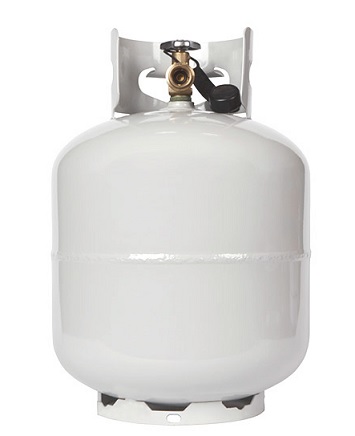Пропан химические свойства, назначение, производство
Описание
Propane is colourless and odourless, with a mercaptan odour. Like all fossil fuels, propane
is a non-renewable energy source. Propane is a gas derived from natural gas
and petroleum. It is found mixed with natural gas and petroleum deposits. Propane is
called a ‘fossil fuel’ because it was formed millions of years ago from the remains of tiny
sea animals and plants. Propane is a clean-burning, versatile fuel. It is used by nearly
everyone, in homes, on farms, by business, and in industry mostly for producing heat and
operating equipment. Propane is one of the many fossil fuels included in the liquefied
petroleum gas (LPG) family. Because propane is the type of LPG most commonly used in
the United States, propane and LPG are often used synonymously. Butane is another LPG
often used in lighters.
Химические свойства
Propane is a colorless gas that is odorless when pure (a foul-smelling odorant is often added).

Propane is released to the living environment from automobile exhausts, burning furnaces, natural gas sources, and during combustion of polyethylene and phenolic resins. Propane is both highly inflammable and explosive and needs proper care and management of workplaces. Its use in industry includes as a source for fuel and propellant for aerosols. Occupational workers exposed to liquefi ed propane have demonstrated skin burns and frostbite. Propane also causes depression effects on the CNS.
Физические свойства
Propane is a colorless, odorless, flammable gas that follows methane and ethane in the alkane
series. The root word prop comes from the three-carbon acid propionic acid, CH3CH2COOH.
Propionic acid comes from the Greek words protos meaning first and pion meaning fat.It was
the smallest acid with fatty acid properties. Propane is the gas used to fuel barbecues and camp
stoves giving it the common name bottled gas.It is marketed as liquefied petroleum gas (LPG)
or liquefied petroleum; it should be noted that LPG is often a mixture that may contains
butane, butylene, and propylene in addition to propane. In addition to cooking, propane can
be used as an energy source for space heating, refrigeration, transportation, and heating appliances
(clothes dryer).
Propane can be stored as liquid in pressurized (approximately 15 atmospheres) storage tanks
and/or at cold temperatures and vaporizes to a gas at atmospheric pressure and normal temperatures.
This makes it possible to store a large volume of propane as a liquid in a relatively
small volume; propane as a vapor occupies 270 times the volume of propane in liquid form.
This makes liquid propane an ideal fuel for transport and storage until needed.
Использование
Propane is used as a fuel gas, as a refrigerant,and in organic synthesis.
Общее описание
A colorless gas with a faint petroleum-like odor. PROPANE is shipped as a liquefied gas under its vapor pressure. For transportation PROPANE may be stenched. Contact with the unconfined liquid can cause frostbite by evaporative cooling. Easily ignited. The vapors are heavier than air and a flame can flash back to the source of leak very easily. The leak may be either a liquid or vapor leak. The vapors can asphyxiate by the displacement of air. Under prolonged exposure to fire or heat the containers may rupture violently and rocket.
Реакции воздуха и воды
Highly flammable.
Профиль реактивности
PROPANE is incompatible with strong oxidizing agents.
Опасность
Asphyxiant. Flammable, dangerous fire
risk, explosive limits in air 2.4–9.5%. For storage,
see butane (note).
Угроза здоровью
Propane is a nontoxic gas. It is an asphyxiate.At high concentrations it shows narcoticeffects.
Пожароопасность
Behavior in Fire: Containers may explode. Vapor is heavier than air and may travel a long distance to a source of ignition and flash back.
Профиль безопасности
Central nervous system
effects at high concentrations. An
asphyxiant. Flammable gas. Highly
dangerous fire hazard when exposed to heat
or flame; can react vigorously with oxidizers.
Explosive in the form of vapor when
exposed to heat or flame. Explosive reaction
with ClO2. Violent exothermic reaction with
barium peroxide + heat. To fight fire, stop
flow of gas. When heated to decomposition
it emits acrid smoke and irritating fumes.
Возможный контакт
Flammable gas. May form explosive
mixture with air. Incompatible with oxidizers (chlorates,
nitrates, peroxides, permanganates, perchlorates, chlorine, bromine, fluorine, etc.); contact may cause fires or explo-
sions. Keep away from alkaline materials, strong bases,
strong acids, oxoacids, epoxides. Liquid attacks some plas-
tics, rubber and coatings.
Канцерогенность
Propane is an anesthetic
and is nonirritating to the eyes, nose, or throat. Direct
skin or mucous membrane contact with liquefied propane
causes burns and frostbite. At air concentration levels
below 1000 ppm, propane exerts very little physiological
action. At very high levels, propane has CNS depressant
and asphyxiating properties; its target organ is the central
nervous system.
Перевозки
UN1978 Propane, Hazard Class: 2.1; Labels:
2.1-Flammable gas. UN1075 Petroleum gases, liquefied or
Liquefied petroleum gas, Hazard Class: 2.1; Labels:
2.1-Flammable gas. Cylinders must be transported in
a secure upright position, in a well-ventilated truck.
Protect cylinder and labels from physical damage. The
owner of the compressed gas cylinder is the only entity
allowed by federal law (49CFR) to transport and refill
them. It is a violation of transportation regulations to
refill compressed gas cylinders without the express written
permission of the owner.
Методы очистки
Purify propane by bromination of the olefinic contaminants. Propane is treated with bromine for 30minutes at 0o. Unreacted bromine is quenched, and the propane is distilled through two -78o traps and collected at -196o [Skell et al. J Am Chem Soc 108 6300 1986]. It autoignites at 450o and the flash point is -104o. It is highly FLAMMABLE and is available in metal cylinders. [Beilstein 1 H 103, 1 I 33, 1 II 71, 1 III 204, 1 IV 175.]
Утилизация отходов
Return refillable compressed
gas cylinders to supplier. Dissolve or mix the material
with a combustible solvent and burn in a chemical
incinerator equipped with an afterburner and scrubber. All
federal, state, and local environmental regulations must
be observed.
Пропан препаратная продукция и сырье
сырьё
препарат